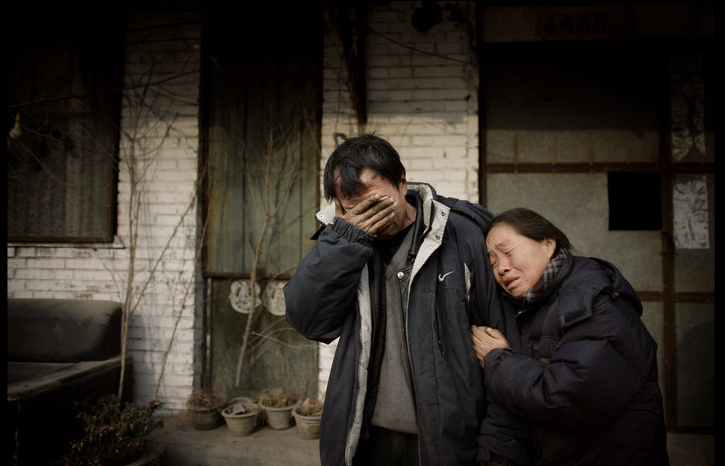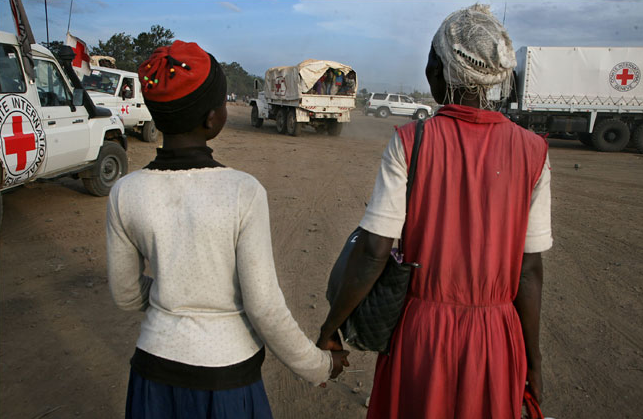Compassion fatigue may be one problem confronting photojournalism, but as long as photographers continue to provide images of emotional intensity and depth, the viewing public has the opportunity for greater understanding, solidarity, and response. Two photographs, one from this week and another from a month ago, provide object lessons in thinking about powerful forces shaping the globe today. The first image is from China:
The Washington Post caption said, “A couple witnesses the demolition of their house in Beijing. With soaring housing prices, some urban residents say they are being evicted to make way for new development without being compensated enough to buy new homes.” The imagetext is highly paratactic: we are to infer that this couple was evicted and inadequately compensated. It could be that they decided to move–time to downsize, perhaps–and got a good price but are shaken anyway by leaving what was a beloved home. Maybe, but I think we can assume the worst.
They look as if they are being crushed by the great weight of uncontrolled loss. Each is distraught, so much so that rather than “witness” the demolition, they can’t bear to look. She cleaves to him as if she would collapse otherwise; though supporting her, he looks as if something is giving way inside. Though joined to each other, each seems isolated by their common desolation. Their winter coats heighten the sense of vulnerability: she is bundled up but still hugging him; his sweater is exposed, perhaps because he is wearing two coats. They seem to be wearing all they have, already succumbing to homelessness.
The second image also was taken during a time of dislocation.
The New York Times caption said, “A Luo mother and daughter fleeing the fighting in Nakuru waited to be evacuated by the Kenyan Red Cross on Saturday.” They are lucky, as they have not yet been mutilated, raped, or killed, and the Red Cross trucks that are there for them may arrive too late for others. But they are facing deportation and perhaps the permanent loss of their home; even if they return, their sense of security may be gone forever.
An image of backs, not faces, and a long view of canvas-covered trucks might seem to have little emotional resonance. The mother and daughter are deeply evocative, however. The mother is not yet old, nor the girl yet an adult, but the girl’s age tells us that both are moving toward unknown and inevitable change. (If they are lucky enough to grow older, they are likely to grow apart.) But now they are walking together, beautifully so. They are linked most obviously by their clasped hands joining them at the hip, but also by the alteration of red and white in the clothes, and by their heads each turned enough to have their lines of sight intersect on the truck moving down the road ahead. They are separate people yet bound together in the mutual obligation and trust of family life. The mother has not only her daughter’s hand but also a shoulder bag and another bag in her right hand. She will keep the girl close to her and try to provide for them both. The girl carries only herself. That is plenty, as she is the future.
The first picture is at odds with the incredible increase in prosperity and living standards experienced by many in China today, and so it is easily rationalized as another example of “creative destruction.” The Nike swoosh on the man’s jacket marks that dimension of the photograph; the degree of irony is up to you. As far as many Chinese are concerned, this might be a very good gamble. The photograph bears witness to something else, however. The destruction is never creative for those being destroyed.
The second photograph goes against the grain of the news from Africa. Once again, years of slow progress are lost in days as another nation plunges into civil war and anarchy. Once again, we read of ethnic violence, marauding gangs, horrible atrocities. And yet this photograph poses the deportees as if they were looking into a vista of economic development and prosperity. They should look like the couple in the first image, yet they seem poised, interested, and ready to move forward. (Likewise, boosters for capitalism would tell the Chinese couple to buck up and look like these two.) The point here is not that one can flee for progress, but that amidst the ravages of African violence many people will remain capable of loving and caring for one another.
Both photographs have a capacity for emotional resonance that can help us better understand global change. Economic development and political violence are two of the most powerful forces at work in the world today. We need to remember that the first can harm people, and that people can survive and overcome the second. To think otherwise in each case is to render people disposable.
Photographs by Oded Bality/Associated Press and Evelyn Hockstein/New York Times.


i just stumbled on your site and am fascinated by it. you’ll see this post featured in our little Just Post roundtable in a few days. peace.